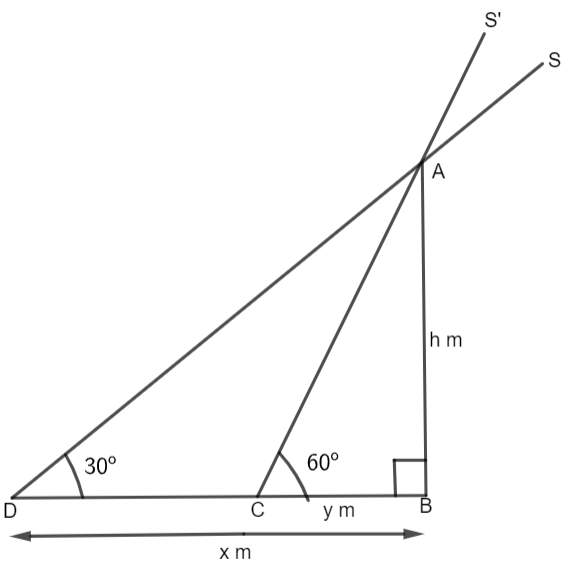Question
Question: The shadow of a tower standing on level ground is found to be 40 m longer when the Sun’s altitude is...
The shadow of a tower standing on level ground is found to be 40 m longer when the Sun’s altitude is 30∘ than when it was 60∘. Find the height of the tower. (Given 3=1.732)
Solution
To solve the given question, we will assume that the height of the tower is h. Then, we will assume that when the sun’s altitude is 30∘, the length of the shadow of the building is x and when the sun’s altitude is 60∘, the length of the shadow of the building on the ground is y. Then, we will develop a relation between x and y using the information given in the question that the difference in x and y is 40 m. Now, we will apply trigonometry in the triangle formed by the length of the shadow when the sun's altitude is 30∘ and the height of the building as h.
Complete step-by-step answer:
To start with, we are going to first draw a rough sketch. In this, we are considering the length of the shadow on level ground as x when the sun’s altitude is 30∘ and the length of shadow as y when the sun’s altitude is 60∘. The height of the tower is h.

In the figure, BC and BD are the lengths of the shadows when the sun’s altitude is 60∘ and 30∘ respectively. AB is the height of the building. S and S’ are positions of the sun. Now, it is given in the question that the difference in length of shadows is 40m. Thus, we will get,
x−y=40m.....(i)
Now, we will consider the right-angled triangle ABD. We know that in any right-angled triangle the ratio of the perpendicular to the base is given by tan of the angle between the hypotenuse and the base. Thus, we can say that,
tanD=BDAB
⇒tan30∘=xh
Now, the value of tan30∘=31. So, we have,
⇒31=xh
⇒x=h3.....(ii)
Now, we will consider the right-angled triangle ABC. In this triangle, BC is the base and AB is the perpendicular. So, we have,
tanC=BCAB
⇒tan60∘=yh
Now, the value of tan60∘=3. So, we have,
⇒3=yh
⇒y=3h.....(iii)
Now, we will put the values of x and y from (ii) and (iii) to (i). Thus, we will get,
⇒h3−3h=40m
⇒33(h3)−h=40m
⇒33h−h=40m
⇒32h=40m
⇒h=203m
⇒h=20×1.732=34.64m
Thus, the height of the building is 34.64 m.
Note: While solving the question, we have assumed that the building is perfectly perpendicular to the ground level. Also, we have assumed the building as a straight line and not as a 3D object because in 3D, the shadow of each dimension of the building would be different and we are not given this much information to solve the question by considering 3 dimensions of the building.
